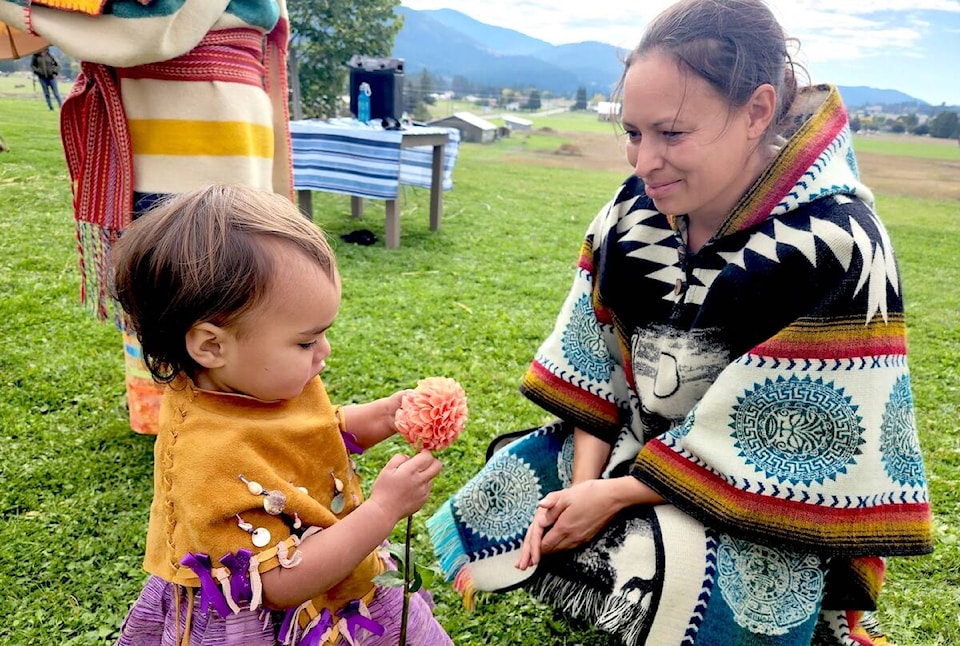Celebrations to mark National Truth and Reconciliation Day were informative and often emotional, but organizers and participants said it’s helping to heal wounds and strengthen connections within the Boundary Region.
Crowds gathered at Boundary Museum and Archives on Saturday to mark the official day with the Boundary Metis Community Association hosting talks, drumming, presentations and a free buffet lunch for everyone that attended.
Before the official start at 10 a.m., a teepee and tables were set up for people who came early to have a place to sit, said organizer Daina Shaw, president of the Boundary Metis Community Association.
The day began with a sunrise drumming and prayer ceremony to welcome the sun and everyone that attended, many of whom wore orange shirts to show their support for Indigenous and Metis people.
People were welcome to come up and speak about the day, its significance, personal experiences and their hopes for reconciliation. Some of them related to generational trauma caused by residential schools and systemic racism. Sam White, a third generation residential school survivor, referred to the residential schools and later day schools as prisons, because real schools don’t have cemeteries.
There was plenty of messages of hope and progress, though, including the presentation of a “survivor’s quilt” and talks about the progress of the Aboriginal Head Start program, which was described as the opposite of residential schools, where Indigenous and Metis children are taught about their heritage and encouraged to explore it.
It’s still an emotional day, no matter the feelings people have coming to the presentations, said Shaw.
“There were times it was emotional and I cried a little at some of it,” she said. “I didn’t expect to because it didn’t impact my family directly in the same way. But it’s hard not to when so many people have so many intense emotions about it. It’s not an easy topic to discuss, but it’s very important we do so.”
She didn’t connect with her Metis roots until she was a teenager, she explained. Even then, she was horrified to discover residential schools were still running as recently as 1997.
It’s become even more important since the discovery of mass graves in former residential school sites, she added, as it brought what was rarely spoken about openly to the forefront. Now more people are talking about it and demanding action, which has been the hope of many. However, reconciliation cannot happen until there is action to back up those words, she said.
Having National Truth and Reconciliation Day celebrated at the museum was an appropriate place and administration was happy to help plan and organize, said curator Mathieu Drolet.
As a building originally constructed out of colonization, it’s the mandate of the museum to help bridge the gap between Indigenous and colonial histories.
“For us this is very significant because we have First Nations in our staff and we are trying to do the right thing,” he said.
Celebrations were originally to be held in Gyro Park, but organizers wanted some privacy. He wanted to offer them a space to hold this event in a respectful place.
This day is meant for people to set aside time to think about the truth about Indigenous treatment by colonization, how they can reconcile their feelings and actions to be better informed of issues and what actions they can take to practice reciprocity in their daily lives. The Moose Hide Campaign has many resources to help people understand the history of Truth and Reconciliation, as well as resources and actions they can take to incorporate it into their lives, said Victoria Runge, of Boundary All Nations Aboriginal Council.
People can feel overwhelmed and confused as to what the day is and where to start to look for accurate resources, Runge stated in an email. People can find resources at moosehidecampaign.ca and the National Centre for Truth and Reconciliation at https://nctr.ca/ to find information and register for free courses.
In the spirit of working together and shared histories, Laura Savinkoff spoke as a member of the Doukhobors of Grand Forks and the Boundary Region.
It’s fitting to have celebrations on the grounds of the museum, she said, as it was once a school where Doukhobor children were forced to go and while there, they were not allowed to speak their language or learn about their heritage.
“It was enforced and there was violence,” she said. “We also had our children taken.”
This had gone on for decades, even in Russia where the Tsarist government took their children. Most Doukhobors had left Russia by 1899, before the Soviet Union existed. The last was the Sons of Liberty colony children who were rounded up in the late 1950’s, among them was Savinkoff’s husband, who was taken violently by authorities after he witnessed them attacking his father and they searched haystacks with pitchforks.
There is a kinship between the Doukhobors and Indigenous, she said, not just in shared tragedies, but in collaboration.
“When we first arrived in Saskatchewan, the first ones to help us were the Indigenous peoples that were there,” she said. “They taught us about the native plants and how to work the land.”
Reconciliation can be a hard subject to tackle, but this is a day to celebrate Indigenous people and learn more about the diverse cultures and histories, said Grand Forks Mayor Everett Baker in a statement. The city is proud of the relationships it’s cultivated and will continue to do so for the betterment of the region as a whole.
